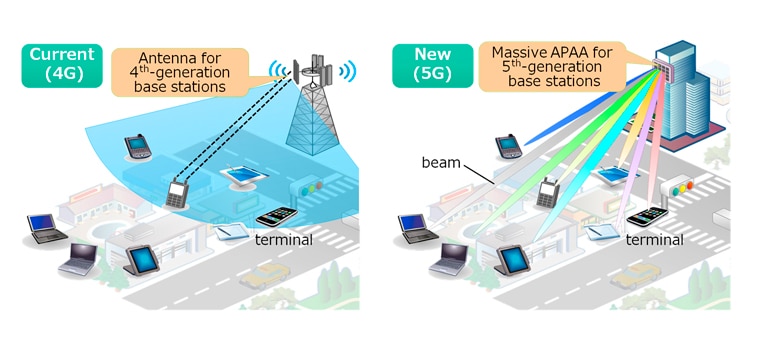FOR IMMEDIATE RELEASE No. 2984
Mitsubishi Electric's New Multibeam Multiplexing 5G Technology Achieves 20Gbps Throughput
Will enable faster, higher-quality connections in crowded urban areas
TOKYO, January 21, 2016 - Mitsubishi Electric Corporation (TOKYO: 6503) has developed a new multibeam multiplexing radio communication technology for base stations of envisioned fifth-generation (5G) mobile communication systems by combining tens of active phased-array antennas with massive antenna elements (massive APAAs) and a new precoding technology for parallel transmission of data streams by transmitters. The wideband communication technology will enable high-speed communication in high-frequency bands expected to be used for 5G systems. The new multibeam multiplexing technology will achieve transmission speeds of 20Gbps, or around 60 times faster than current 4G mobile base stations that use multi-input multi-output (MIMO) technology (as of January 21, 2016). Details will be announced at the IEICE Technical Committee on Radio Communication Systems in Tokyo on March 2.

Massive MIMO technology that would facilitate the use of more than several hundred antenna elements is drawing attention as a way to compensate for propagation loss in the high-frequency bands (from 4GHz) that will be used for 5G. Fully digitized signal processing would require enormous digital circuitry and power consumption, so one of the practical solutions is a hybrid configuration that combines analog and digital processing. The massive APAA technology developed by Mitsubishi Electric is a proven technology that is already used commercially for satellites and other systems.
Mitsubishi Electric developed its new multibeam multiplexing technology by combining massive APAAs and precoding technology in transmitters that deliver increased transmission power to overcome propagation loss in high-frequency bands. In comparison with two-beam transmissions of current 4G mobile base stations, up to 16-beam transmissions can achieve up to 20Gbps to satisfy needs for higher data rates.
When mobile terminals are in proximity in a crowded environment, signals from base stations can interfere with each other. In conventional diagonalization precoding schemes, the transmission power of interfering signals is lowered to reduce interference, but this also results in decreased transmission speeds. Mitsubishi Electric's solution is its new nonlinear multi-diagonalization precoding technology combining multi-diagonalization precoding, with inherent interference, and nonlinear operation, which removes interference through multi-diagonalization precoding. Since transmission power does not have to be lowered, the result is high-capacity communication at 20Gbps in crowded environments.
Note that the releases are accurate at the time of publication but may be subject to change without notice.
